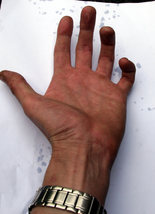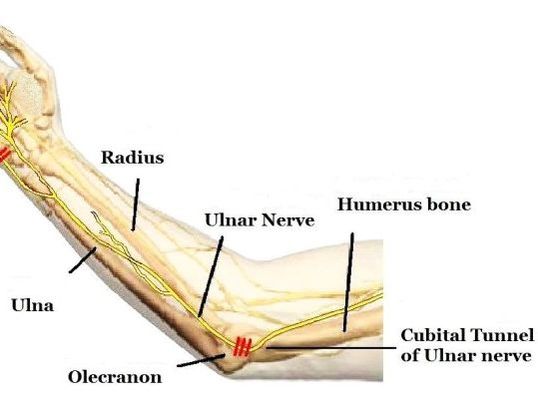Cubital Tunnel Syndrome (CuTS)

What is Cubital Tunnel Syndrome?
Common Treatments may include:
Helpful Links:
- Cubital Tunnel Syndrome (CuTS) is the stretching or irritation of the ulnar nerve within a small channel created at the inside edge of the elbow by the bony bulbous end of the elbow bone with a thick ligament laying over the top.
- The ulnar nerve is one of the three main nerves that provide power and sensation to the arm.
- The ulnar nerve is the "power cord" that travels from the neck to the fingers, supplying sensation to the small finger and and half of the ring finger. This nerve also supplies power to the small muscles in the hand that straighten the ends of the fingers and spread the hand wide open.
- At the elbow, the nerve lies in a narrow canal (the Cubital Tunnel) at the inside of the elbow.
- When you hit your "funny bone", you are actually hitting this nerve.
- Common Symptoms
- Pain in the small finger side of the hand and the forearm.
- Pain may radiate to the elbow and even through the upper arm towards the arm pit.
- Numbness and tingling, typically in the small and half of the ring finger with activity.
- Nighttime numbness in the hand, particularly the ring and small fingers.
- Feeling clumsy or frequently dropping objects.
- In severe cases, the small muscles that lie between the hand bones may become soft or soggy and the ring and small fingers lose the ability to straighten. The hand assumes a "claw-like" position.
- It becomes difficult to perform fine-motor activity such as picking up pills or coins or putting on earrings.
- Grasping and holding objects securely in the hand becomes more difficult.
Common Treatments may include:
- Use of an elbow brace, splint or orthotic at night to prevent the elbow from bending beyond 90 degrees. As the elbow bends more than 90 degrees, the nerve becomes increasingly stretched around the elbow bone as it lies in the canal.
- Implementing Ergonomic Improvements & Activity Modification
- Perform activities with the elbow open more than 90 degrees whenever possible.
- Avoid repetitive bending or straightening of the elbow.
- Avoid placing pressure against the forearms or leaning on the elbows.
- Use of Heat and cold
- Use cold packs for acute pain or swelling.
- Use heat packs to control more chronic pain or relax the muscles.
- Wearing a light compression elbow sleeve at night may help control swelling and provide a comforting, neutral warmth.
- Perform forearm stretches and nerve gliding exercises.
- Use of topical pain relieving creams if helpful and as needed.
- Modalities such as ultrasound, electrical stimulation and iontophoresis may be helpful to reduce pain and inflammation.
- Therapeutic taping may be helpful to reduce pain and tingling/numbness.
- A short course of anti-inflammatory medications, such as NSAIDs, may be helpful as prescribed by an MD or over-the-counter (Advil, Aleve) if not contraindicated by other medical conditions.
- If conservative treatment methods do not alleviate the symptoms, surgical options may be considered.
Helpful Links:
- American Society of Hand Therapists (ASHT) - PDF Educational Handout
- American Society for Surgery of the Hand (ASSH)-Website Information
- American Academy of Orthopaedic Surgeons (AAOS) - Website Information
- California Orthopaedic Surgery & Hand Institute - a detailed powerpoint/movie presentation
Proudly powered by Weebly
